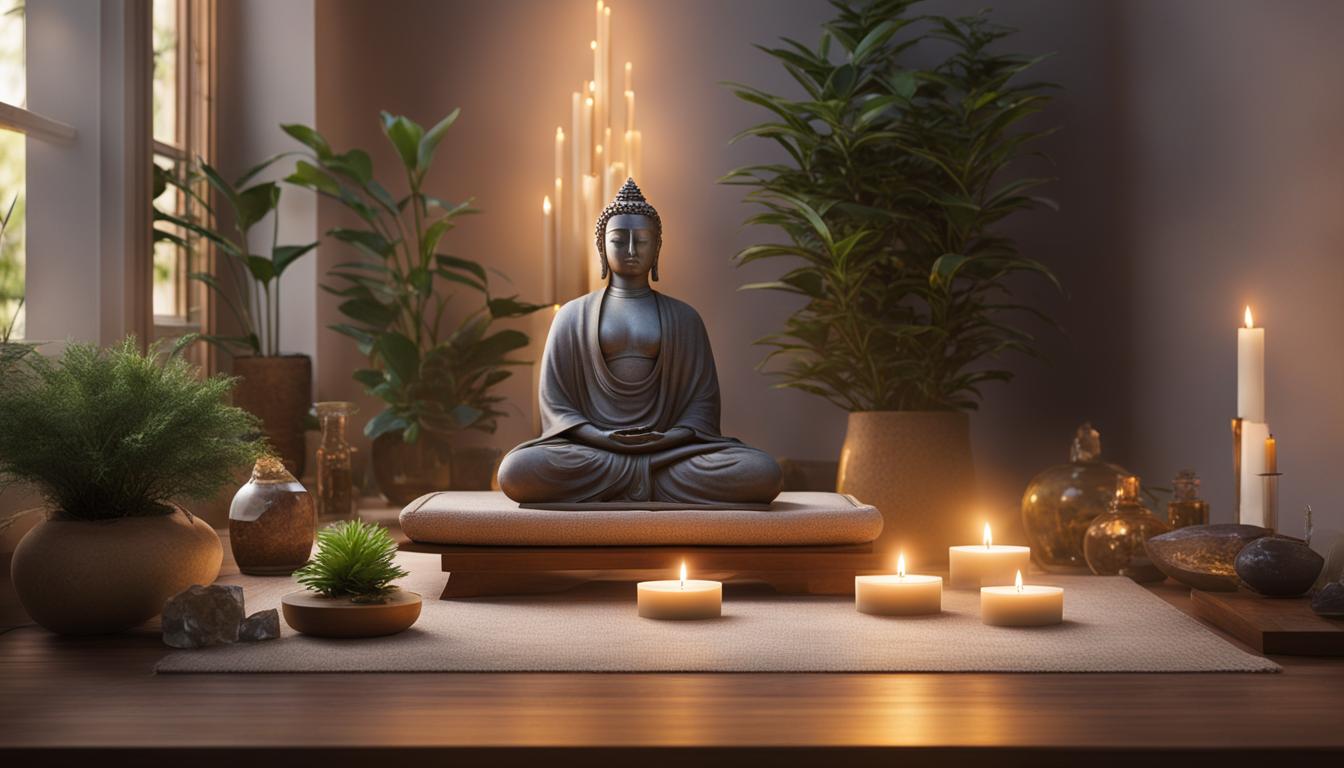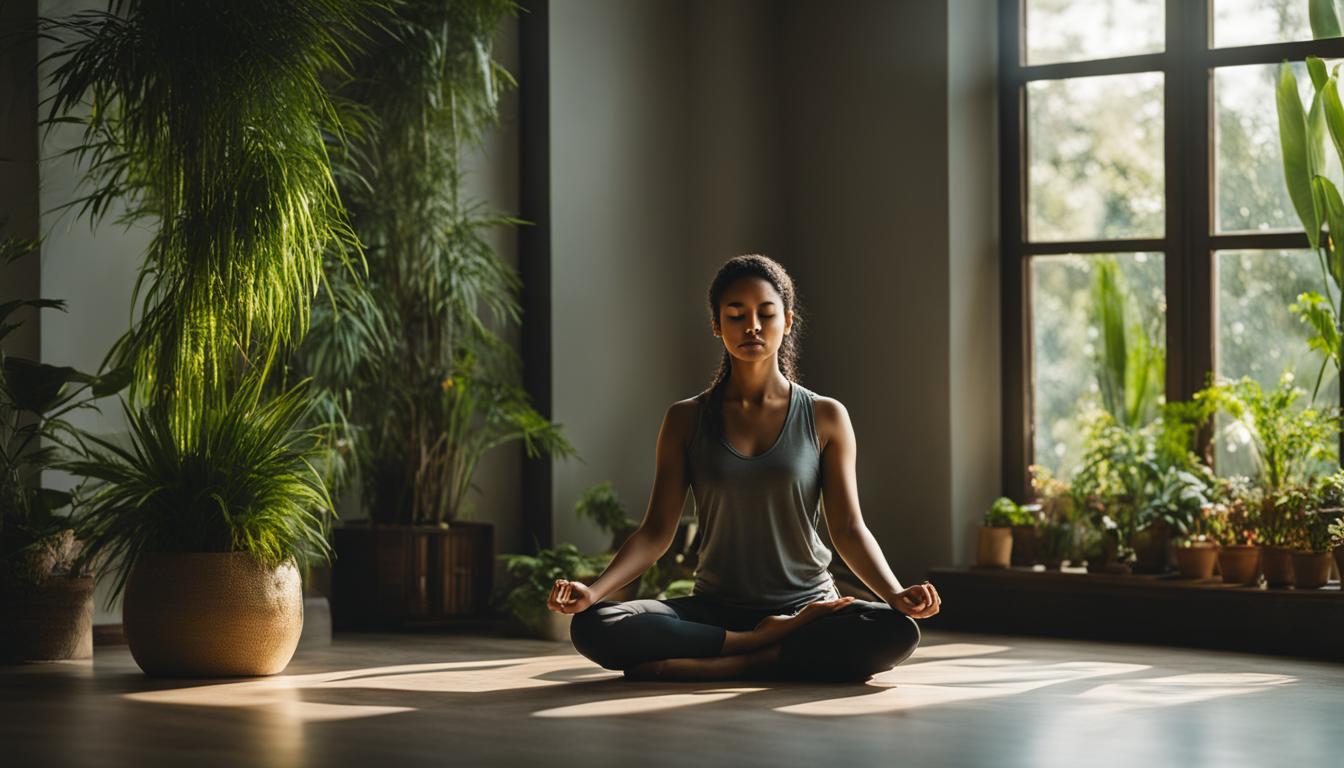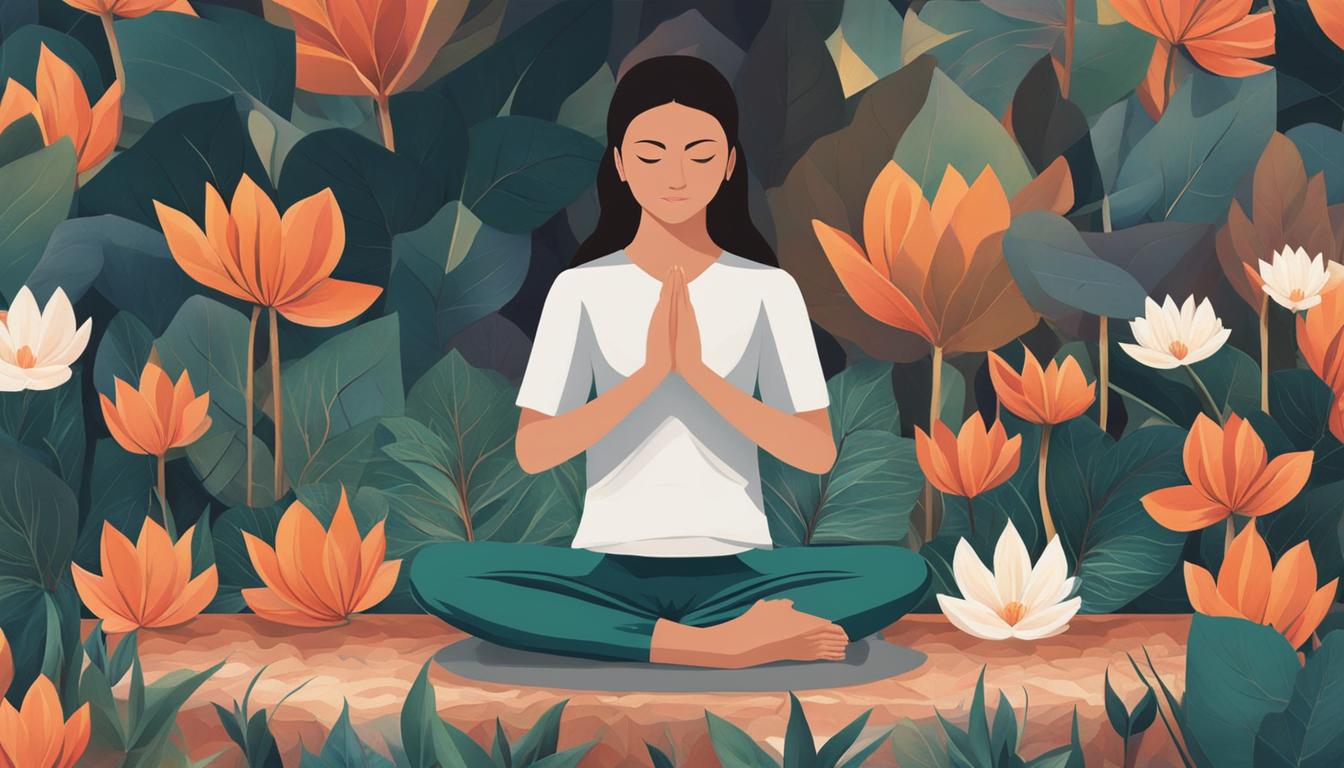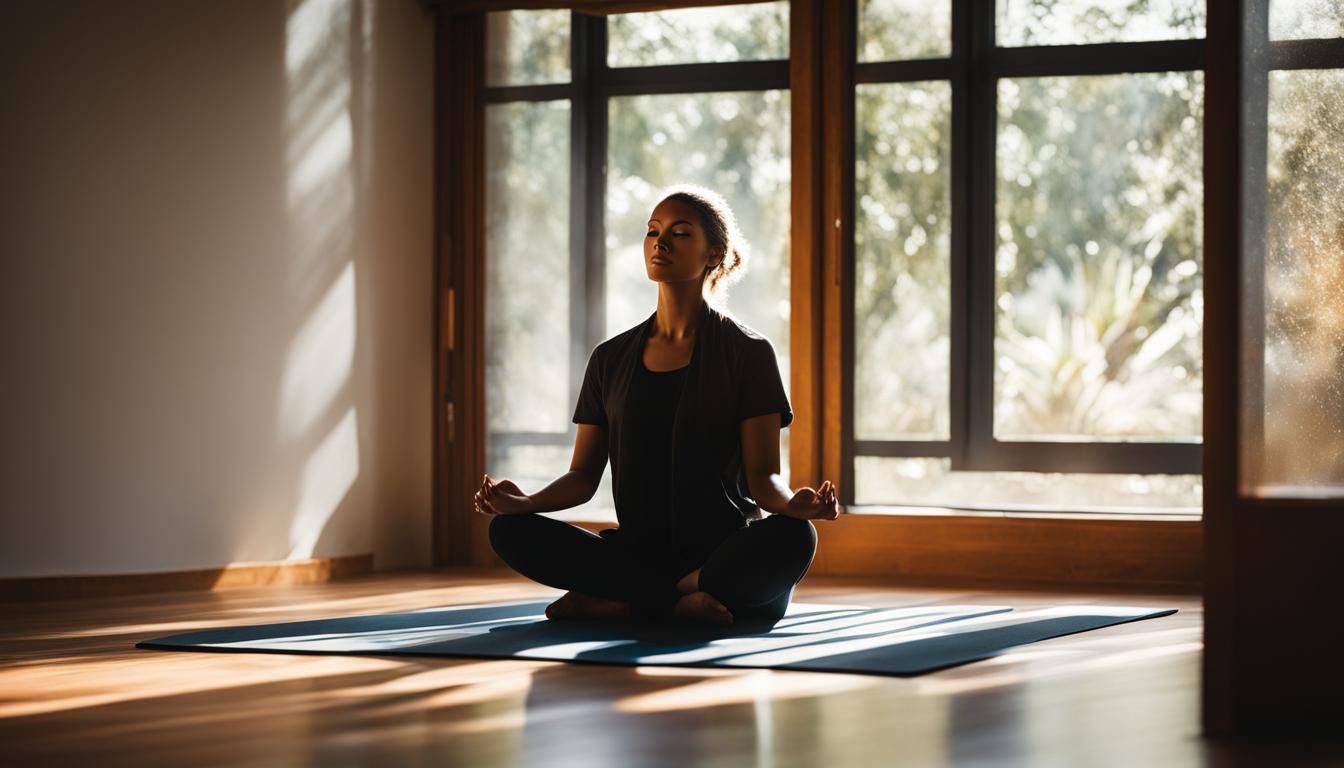Welcome to the beginner’s guide to meditation, a practice that can bring you inner peace, reduce stress, and clarity to your mind. If you’re new to meditation and looking to start your journey, you’ve come to the right place. In this guide, we’ll provide you with practical tips and techniques to help you get started and experience the incredible benefits of meditation.
Key Takeaways:
- Meditation is a powerful practice for finding inner peace and reducing stress.
- Creating a sacred space can enhance your meditation experience.
- Finding a comfortable posture is crucial for effective meditation.
- Using the breath as an anchor can help focus your mind during meditation.
- Observing thoughts without judgment is an essential aspect of meditation.
The Importance of Creating a Sacred Space
When embarking on a meditation journey, it’s crucial to establish a sacred space that fosters tranquility and peace. Creating a dedicated area solely for your meditation practice can significantly enhance your experience and deepen your connection with yourself. This sacred space should be a reflection of your inner sanctuary, a sanctuary where you can truly let go and find solace amidst the chaos of everyday life.
To begin, find a quiet spot in your home where you can retreat from distractions and interruptions. This space can be as simple as a corner of a room or a small nook where you feel comfortable and undisturbed. Clear away any clutter or unnecessary objects to create a sense of openness and serenity.
Personalize your sacred space with objects that inspire a sense of calm and tranquility. This can include elements such as candles, crystals, plants, or meaningful artwork. Surrounding yourself with these objects can help create a soothing ambiance and set the intention for your meditation practice.

Quotes:
“Your sacred space is where you can find yourself again and again.”
– Joseph Campbell
“In the space between chaos and shape, there is peace.”
– The Buddha
Benefits of a Sacred Space:
- Facilitates relaxation and focus
- Creates a physical reminder to practice meditation regularly
- Enhances the overall experience and deepens connection to inner self
- Provides a sanctuary for introspection and personal growth
By intentionally crafting a sacred space, you are setting the stage for your meditation practice, inviting peace and stillness into your life. This dedicated space serves as a gentle reminder to prioritize self-care and allows you to fully immerse yourself in the present moment, free from external distractions.
Finding Posture and Comfort
When it comes to meditation, finding the right posture and level of comfort is crucial. This will help you maintain focus and relaxation throughout your practice. Here are some beginner-friendly meditation techniques and tips to help you get started.
Choose a Sitting Position
Experiment with different sitting positions to find the one that works best for you. Traditional postures like the lotus or half-lotus may be challenging for beginners, so don’t feel discouraged if you can’t achieve them right away. Sitting on a cushion or a chair with your back straight and relaxed is a great alternative. The goal is to find a position that allows you to stay alert and comfortable throughout the meditation session.
Relax and Let Go
Before you begin your meditation, take a moment to relax your body and let go of any tension or stress. Close your eyes and bring your attention to your breath, allowing it to deepen naturally. Scan your body from head to toe, consciously releasing any areas of tightness or discomfort. Creating a sense of physical ease will help you enter into a more peaceful state of mind.
Use Props if Needed
If you find it difficult to maintain a comfortable posture on your own, don’t hesitate to use props. Cushions, blankets, or meditation benches can provide additional support and help you find the right alignment. Experiment with different combinations of props until you find the one that allows you to sit comfortably for the duration of your meditation practice.
Remember, finding a posture that works for you is a personal journey. Don’t compare yourself to others or feel pressured to achieve a specific pose. The most important thing is to prioritize your comfort and allow yourself to fully immerse in the present moment.
By finding the right posture and level of comfort, you are setting the foundation for a successful meditation practice. Take the time to explore different sitting positions, relax your body, and use props if needed. With patience and consistency, you’ll soon discover the joy and peace that meditation brings.

The Breath as Your Anchor
Meditation is a practice that often begins with focusing on the breath. The breath serves as our anchor, grounding us in the present moment and helping to quiet the mind. By bringing attention to the breath, we can cultivate mindfulness and deepen our meditation experience.
One way to use the breath as an anchor is to simply observe its natural rhythm. Close your eyes, take a deep breath in, and notice the sensation of the breath entering your body. Pay attention to the rise and fall of the abdomen or the feeling of air passing through your nostrils. Whenever your mind starts to wander, gently bring your focus back to the breath, allowing it to guide you back to the present moment.
Another technique to enhance your meditation practice is to explore different breathing exercises. Deep breathing, also known as diaphragmatic breathing, involves taking slow, deep breaths that fill your lungs completely. This can help induce a state of relaxation and increase the sense of calm during meditation. Alternatively, you can try alternate nostril breathing, where you inhale through one nostril and exhale through the other, promoting balance and harmony within the body and mind.
Benefits of using the breath as your anchor:
- Enhances focus and concentration
- Increases self-awareness
- Reduces stress and anxiety
- Promotes a sense of calm and relaxation
- Deepens the meditation experience
“The breath is always with us, a constant presence in our lives. By using it as our anchor in meditation, we can access a place of stillness and peace within ourselves.”
Remember, meditation is a practice, and it takes time to cultivate. Be patient with yourself and allow the breath to guide you on this journey of self-discovery and inner peace. With regular practice and the breath as your anchor, you’ll find that meditation becomes a valuable tool for learning and personal growth.

Embracing Thoughts and Letting Go
During meditation, it’s common for thoughts to arise. As a newcomer to meditation, it’s important to approach these thoughts without judgment. Remember, the goal of meditation is not to stop thinking entirely, but to observe your thoughts without getting caught up in them. Use your breath or chosen point of focus as an anchor to gently redirect your attention when thoughts arise. This practice helps cultivate a sense of mindfulness and presence in the moment.
One technique for embracing thoughts during meditation is to imagine them as passing clouds in the sky. Instead of holding onto thoughts or trying to push them away, observe them as they come and go, allowing them to naturally pass through your mind. By acknowledging and accepting your thoughts without attachment or judgment, you can create a sense of spaciousness and clarity within your meditation practice.
“In meditation, don’t try to erase your thoughts. Instead, let them flow like water, observing them with a gentle curiosity.”
– Unknown
It’s important to remember that thoughts are a natural part of the human experience. Being kind and patient with yourself as you navigate meditation as a beginner is essential. The more you practice observing and gently letting go of thoughts during meditation, the more you will develop the ability to cultivate a calm and focused mind.
Techniques for Embracing Thoughts:
- Observe thoughts without judgment
- Use the breath or chosen point of focus as an anchor
- Imagine thoughts as passing clouds in the sky
- Acknowledge and accept thoughts without attachment
- Be kind and patient with yourself as a beginner

By embracing thoughts and letting go, you can cultivate a greater sense of peace and serenity in your meditation practice. Remember to approach your thoughts with a gentle curiosity, observing them without judgment, and redirecting your attention back to your breath or chosen point of focus. With time and practice, you will develop the ability to maintain a calm and focused mind, even amidst the busy chatter of thoughts.
Guided Meditation and Mantras
If you find it challenging to solely focus on your breath during meditation, guided meditation and mantras can be valuable tools to enhance your practice. Guided meditation involves listening to a recorded voice or using a meditation app to provide instructions and guidance throughout the session. This can be especially helpful for beginners who may find it difficult to maintain focus or feel uncertain about their meditation technique.

Guided meditation allows you to follow along with the instructions, helping you stay present and centered. It can also provide a sense of support and connection as you embark on your meditation journey. Many guided meditations are available for free online or through meditation apps, offering a wide variety of themes and styles to choose from.
In addition to guided meditation, mantras can serve as a powerful tool for beginners. A mantra is a repeated word, phrase, or sound that can help focus the mind and cultivate a sense of calm. By silently repeating a mantra during meditation, you can enhance your concentration and deepen your practice.
Choose a mantra that resonates with you and reflects your intentions or desired state of being. It can be as simple as a single word, such as “peace” or “love,” or a more traditional mantra like “om” or “so hum.” Repeat your chosen mantra silently in your mind, allowing it to anchor your attention and bring you back to the present moment whenever your thoughts start to wander.
Start Small, Stay Consistent
Starting a meditation practice can feel overwhelming, especially for beginners. The good news is that you don’t have to meditate for hours on end to experience its benefits. In fact, starting with just a few minutes of meditation each day is a great way to begin your journey. By setting aside a small amount of time for meditation, you can establish a consistent practice that gradually grows over time.
The key to building a regular meditation habit is consistency. It’s better to meditate for a short duration every day than to have longer sessions sporadically. Consistency allows you to develop the discipline and focus needed to deepen your practice. So, commit to a specific time each day, whether it’s first thing in the morning or before bed, and stick to it.
Remember, meditation is not about the duration of each session but the quality of your presence. Even five minutes of focused meditation can have a profound impact on your mental well-being. As you grow more comfortable with your practice, you can gradually increase the duration. The important thing is to stay committed and make meditation a part of your daily routine.
Benefits of Starting Small and Staying Consistent:
- Reduces the feeling of overwhelm for beginners.
- Establishes a regular meditation habit.
- Builds discipline and focus over time.
- Allows for gradual progression in meditation duration.
- Creates space for personal growth and inner peace.
By starting small and staying consistent, you provide yourself with the opportunity to fully experience the benefits of meditation. It’s a journey that unfolds gradually, and each small step along the way contributes to your overall well-being.

Integrate Meditation into Your Routine
Meditation has numerous benefits for individuals, especially beginners looking to find inner peace and improve their overall well-being. To make meditation a sustainable habit, it is essential to integrate it into your daily routine. By incorporating meditation into your schedule, you can ensure consistency and reap the long-term rewards of this practice.
One important tip for integrating meditation into your routine is to find the best time of day for your practice. Some people prefer meditating in the morning to start their day with a sense of calm and focus, while others find it helpful to unwind in the evening after a busy day. Experiment with different times to see what works best for you and aligns with your lifestyle.
Another way to integrate meditation into your routine is to create a dedicated space for your practice. Designate a quiet spot in your home where you can retreat and find peace. Surround yourself with objects that inspire serenity, such as candles, cushions, or artwork. By creating a sacred space, you can enhance the atmosphere and make meditation a more enjoyable experience.
Benefits of Integrating Meditation into Your Routine
- Improved focus and concentration
- Reduced stress and anxiety
- Enhanced self-awareness
- Better emotional regulation
- Increase in overall well-being
Integrating meditation into your routine can have profound effects on your mental, emotional, and physical well-being. By making it a regular part of your day, you give yourself the opportunity to experience the transformative power of this practice.

Remember, consistency is key when it comes to meditation. Start with small increments of time, even just a few minutes each day, and gradually increase the duration as you become more comfortable. By staying committed and integrating meditation into your routine, you will cultivate a deep sense of inner peace and harmony.
Celebrate Your Journey
Meditation is a transformative journey of self-discovery, and as beginners, it’s important to celebrate every step along the way. Remember, meditation is not about achieving perfection or reaching a certain milestone; it’s about embracing the process and finding inner peace.
Take a moment to acknowledge and celebrate the small victories in your meditation practice. Whether it’s finding a few moments of stillness amidst a busy day or experiencing a sense of calm during your meditation sessions, these are all signs of progress. Each time you sit down to meditate, you are dedicating time and effort to cultivate mindfulness and connect with your inner self.
As you continue your meditation journey, remember that it’s normal to have moments of restlessness or distraction. Don’t be discouraged by these experiences. Embrace them as opportunities for growth and learning. By observing your thoughts without judgment and gently returning to your point of focus, you are developing invaluable skills for mindfulness and self-awareness. Allow yourself to be kind and patient throughout the process.
“The journey of a thousand miles begins with a single step.” – Lao Tzu
Every time you meditate, you are taking that single step towards a more peaceful and centered life. So, celebrate your commitment to self-care and honor the progress you’ve made. Remember, meditation is a lifelong practice, and each moment of stillness and presence contributes to your overall well-being. Embrace the journey with an open heart and a sense of gratitude for the transformative power of meditation.

The Benefits of Meditation: Insights from Ayurveda
Ayurveda, the ancient holistic system of health, recognizes the numerous benefits of meditation for overall well-being. With its roots in India, Ayurveda emphasizes the importance of achieving balance in the mind, body, and spirit. Meditation plays a vital role in this process, offering profound insights into our inner world and helping us cultivate a harmonious state of being.
According to Ayurveda, meditation helps balance the three doshas – Vata, Pitta, and Kapha – which are the elemental forces that govern our physical and mental well-being. By calming the mind and reducing stress, meditation soothes Vata, the dosha associated with anxiety and restlessness. It also cools Pitta, the fiery dosha linked to anger and irritability, and brings stability to Kapha, the dosha associated with lethargy and attachment. By doing so, meditation creates a sense of equilibrium and promotes optimal health.
The mind-body connection is at the core of Ayurvedic philosophy, and meditation is a powerful tool for enhancing this connection. Regular meditation practice cultivates self-awareness and mindfulness, allowing us to better understand the signals our bodies send us. By developing this awareness, we can make conscious choices that support our physical, mental, and emotional well-being. Meditation also helps to quiet the mind’s chatter, allowing us to tap into our intuition and make decisions from a place of clarity and inner guidance.
Balancing Doshas through Meditation
- Vata Dosha: Calming meditation techniques, such as focusing on the breath or practicing gentle movement meditation, can help soothe Vata and reduce anxiety and restlessness.
- Pitta Dosha: Cooling and surrender-based meditations, such as visualization or loving-kindness meditation, can bring balance to Pitta by alleviating anger and promoting compassion.
- Kapha Dosha: Energizing meditation practices, such as dynamic meditation or chanting, can invigorate Kapha and counteract feelings of lethargy and attachment.
In addition to balancing the doshas, meditation in Ayurveda is also valued for its stress-reducing properties. Chronic stress has a detrimental impact on our health and well-being, and meditation allows us to tap into our body’s natural relaxation response. By activating the parasympathetic nervous system, meditation helps to reduce the production of stress hormones, lower blood pressure, and promote deep relaxation. This leads to a cascade of positive effects on our physical and mental health, including improved sleep, enhanced immune function, and reduced anxiety and depression.

In conclusion, Ayurveda recognizes meditation as a powerful practice for achieving balance, promoting well-being, and deepening the mind-body connection. By incorporating meditation into our daily routines, we can harness its transformative benefits and experience profound insights, inner peace, and improved overall health.
Tips for Establishing a Regular Practice
Starting a meditation practice as a beginner can feel overwhelming, but with the right approach, it can become a valuable part of your daily routine. Here are some practical tips to help you establish a regular meditation practice:
- Start small: Begin with just a few minutes of meditation each day. Set achievable goals that will help you stay motivated and build consistency.
- Be patient with yourself: Remember that meditation is a skill that takes time to develop. Be gentle with yourself and embrace the process, even if your mind feels restless or distracted at first.
- Create a peaceful environment: Find a quiet and comfortable space in your home where you can meditate without distractions. Surround yourself with objects that bring you calm and serenity.
- Seek guidance if necessary: If you’re new to meditation, consider seeking guidance from a teacher, attending a meditation class, or using guided meditation recordings or apps to help you establish a regular practice.
Remember that consistency is key when it comes to meditation. By starting small, being patient, creating a peaceful environment, and seeking guidance if needed, you can establish a regular meditation practice that brings you inner peace and clarity.
“Meditation is not about perfection but about embracing the process.”
Conclusion
As a beginner, starting a meditation practice can be a profound step towards finding inner peace and serenity. By following this beginner’s guide to meditation, you’ve gained valuable insights into the importance of creating a sacred space, finding posture and comfort, and using the breath as your anchor.
Remember, meditation is not about perfection but about embracing the journey. It’s normal for thoughts to arise during your practice; the key is to observe them without judgment and gently return your focus to the breath or chosen point of focus.
By starting small and staying consistent, integrating meditation into your routine, and celebrating your progress along the way, you’ll cultivate a sustainable and transformative meditation practice. Whether you choose guided meditations or prefer silent sessions, the benefits of meditation are vast and can positively impact your well-being.
So take a deep breath and embark on this beautiful journey of self-discovery. Start your meditation practice today, and witness the transformative power it holds for beginners like you. Remember, with each session, you are nurturing your mind, body, and soul, inching closer to a life of inner peace and harmony.
FAQ
What is meditation and why should I try it?
Meditation is a practice that helps individuals find inner peace, reduce stress, and achieve mental clarity. It can provide numerous benefits for overall well-being.
How do I create a peaceful environment for meditation?
Find a quiet spot in your home, surround yourself with objects that inspire serenity, and create a sacred space dedicated to your meditation practice.
What is the best posture for meditation?
There are different options, such as sitting on a cushion or chair. The most important thing is to find a posture that is comfortable and allows for relaxation and comfort during meditation.
How can I focus on my breath during meditation?
Use the breath as an anchor, bringing attention back to the present moment whenever the mind starts to wander. There are also various breathing techniques that can enhance the meditation experience.
What should I do when thoughts arise during meditation?
Approach thoughts without judgment, observe them without getting caught up in them, and gently redirect attention back to the breath or chosen point of focus.
How can guided meditations and mantras enhance my meditation practice?
Guided meditation recordings or apps can provide guidance and structure, while repeating mantras silently can help focus the mind and deepen the meditation experience.
How long should I meditate each day?
Start with just a few minutes and gradually increase the duration over time. The key is to build a consistent practice rather than focusing on the duration of each session.
How can I integrate meditation into my daily routine?
Find the best time of day for meditation and incorporate it seamlessly into your schedule. Making it a habit will help make it a sustainable part of your routine.
Do I need to be perfect at meditation?
No, meditation is not about perfection. Embrace the process, celebrate small victories, and moments of stillness as you embark on your meditation journey.
What are the Ayurvedic perspectives on meditation?
Ayurveda recognizes the benefits of meditation for overall well-being, including balancing doshas, enhancing the mind-body connection, and reducing stress.
How can I establish a regular meditation practice?
Start small, be patient with yourself, create a peaceful environment, and seek guidance if necessary. Consistency is key to establishing a regular practice.


